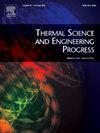Influence of heat insulation on temperature and moisture variations in municipal solid waste landfills under diverse environmental conditions
IF 5.4
3区 工程技术
Q2 ENERGY & FUELS
引用次数: 0
Abstract
Elevated temperatures (ETs) in municipal solid waste (MSW) landfills, caused by the decomposition of organic waste, pose significant risks to landfill liner integrity, increase leachate production and greenhouse gas emissions. Heat accumulation, with ETs exceeding 35 °C, can negatively impact liner performance. Existing heat mitigation strategies, such as gas collection and cover systems, offer limited thermal mitigation. Gas collection mainly focuses on emissions, meanwhile, cover systems often trap heat and degrade over time. Advanced methods like waste-to-energy and heat exchangers are expensive and require high maintenance. In contrast, integrating thermal insulation within landfill liners provides a sustainable and efficient solution. This study evaluates the performance of three insulation materials, rockwool, hot sprayed polyurea (HSP), and casted polyurea (CP), under varying environmental conditions. Laboratory experiments and numerical simulations using ANSYS analyzed their performance across different ETs (40 and 70 °C), moisture conditions (dry and wet), and insulation thicknesses (20, 35, 50 mm). Rockwool demonstrated the best performance in dry conditions, reducing ETs by up to 30 %, but dropped by 13 % when wet. HSP maintained better stability under wet and extreme ETs, with reductions up to 31 % in base conditions and 57 % at 70 °C. CP was effective in moderate ETs and wet conditions but underperformed at high temperatures. Increasing insulation thickness improved thermal resistance, though the significance reduced beyond 35 mm. These results highlight the importance of material selection and configuration in balancing thermal and cost effectiveness of MSW landfill systems and further validate thermal insulation as an effective and sustainable solution.

不同环境条件下隔热对城市生活垃圾填埋场温湿度变化的影响
由有机废物分解引起的城市固体废物(MSW)填埋场温度升高(ETs)对填埋场衬垫的完整性构成重大威胁,增加了渗滤液的产生和温室气体的排放。当ETs超过35°C时,热量积累会对衬垫性能产生负面影响。现有的热缓解策略,如气体收集和覆盖系统,提供有限的热缓解。气体收集主要集中在排放物上,同时,覆盖系统通常会捕获热量并随着时间的推移而降解。先进的方法,如废物转化为能源和热交换器是昂贵的,需要高维护。相比之下,在垃圾填埋场衬垫中集成隔热材料提供了一个可持续和有效的解决方案。本研究评估了岩棉、热喷涂聚脲(HSP)和铸造聚脲(CP)三种保温材料在不同环境条件下的性能。利用ANSYS进行的实验室实验和数值模拟分析了它们在不同温度(40和70°C)、湿度条件(干和湿)和绝缘厚度(20、35、50 mm)下的性能。洛科威在干燥条件下表现最好,减少了高达30%的碳排放,但在潮湿条件下下降了13%。HSP在潮湿和极端温度下保持了更好的稳定性,在基本条件下降低了31%,在70°C下降低了57%。CP在中等et和潮湿条件下有效,但在高温条件下表现不佳。增加绝缘厚度可以改善热阻,但超过35毫米后的显著性降低。这些结果强调了材料选择和配置在平衡城市生活垃圾填埋场系统的热和成本效益方面的重要性,并进一步验证了隔热是一种有效和可持续的解决方案。
本文章由计算机程序翻译,如有差异,请以英文原文为准。
求助全文
约1分钟内获得全文
求助全文
来源期刊

Thermal Science and Engineering Progress
Chemical Engineering-Fluid Flow and Transfer Processes
CiteScore
7.20
自引率
10.40%
发文量
327
审稿时长
41 days
期刊介绍:
Thermal Science and Engineering Progress (TSEP) publishes original, high-quality research articles that span activities ranging from fundamental scientific research and discussion of the more controversial thermodynamic theories, to developments in thermal engineering that are in many instances examples of the way scientists and engineers are addressing the challenges facing a growing population – smart cities and global warming – maximising thermodynamic efficiencies and minimising all heat losses. It is intended that these will be of current relevance and interest to industry, academia and other practitioners. It is evident that many specialised journals in thermal and, to some extent, in fluid disciplines tend to focus on topics that can be classified as fundamental in nature, or are ‘applied’ and near-market. Thermal Science and Engineering Progress will bridge the gap between these two areas, allowing authors to make an easy choice, should they or a journal editor feel that their papers are ‘out of scope’ when considering other journals. The range of topics covered by Thermal Science and Engineering Progress addresses the rapid rate of development being made in thermal transfer processes as they affect traditional fields, and important growth in the topical research areas of aerospace, thermal biological and medical systems, electronics and nano-technologies, renewable energy systems, food production (including agriculture), and the need to minimise man-made thermal impacts on climate change. Review articles on appropriate topics for TSEP are encouraged, although until TSEP is fully established, these will be limited in number. Before submitting such articles, please contact one of the Editors, or a member of the Editorial Advisory Board with an outline of your proposal and your expertise in the area of your review.
 求助内容:
求助内容: 应助结果提醒方式:
应助结果提醒方式:


